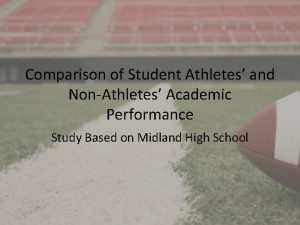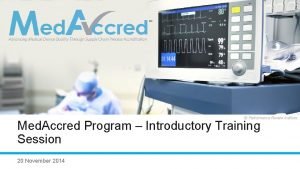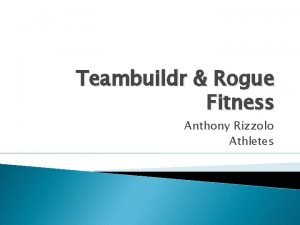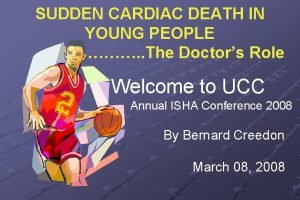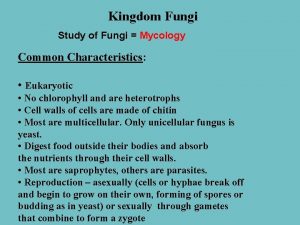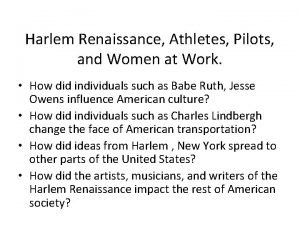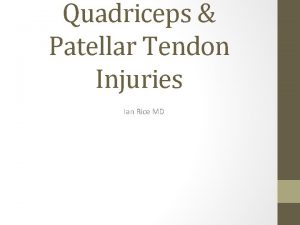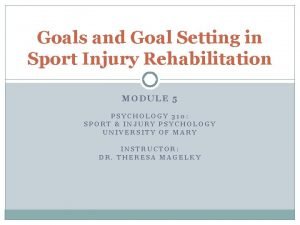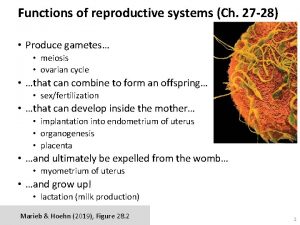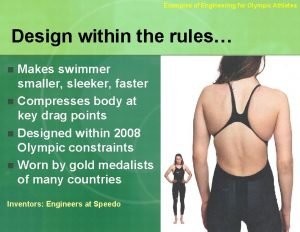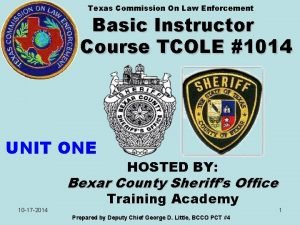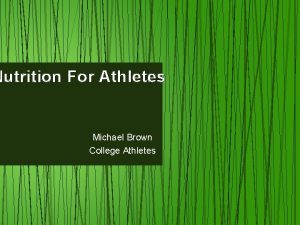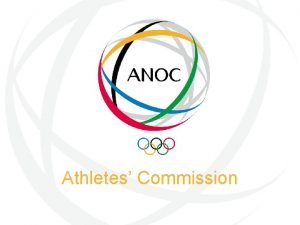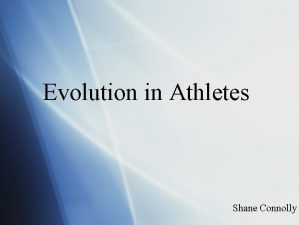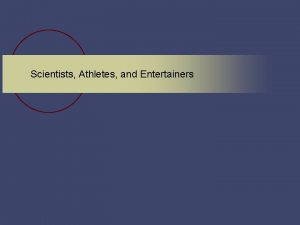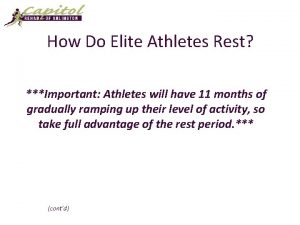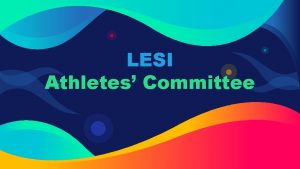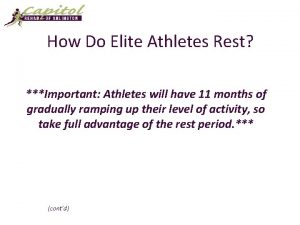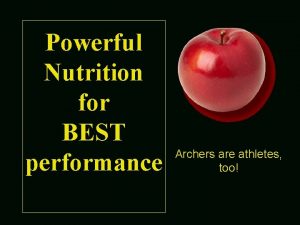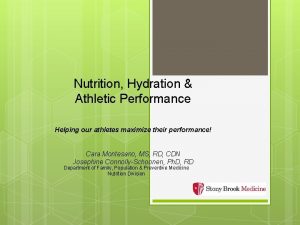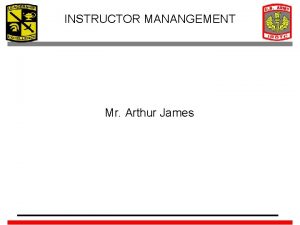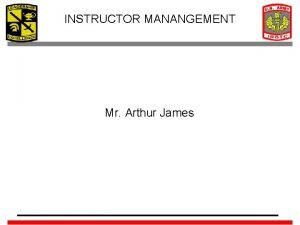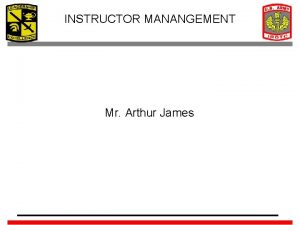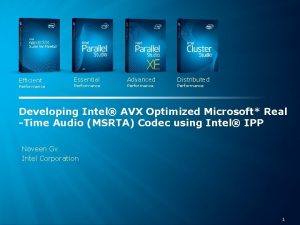PERFORMANCE NUTRITION INTRODUCTORY NUTRITION FOR ATHLETES INSTRUCTOR GREG






















- Slides: 22

PERFORMANCE NUTRITION INTRODUCTORY NUTRITION FOR ATHLETES INSTRUCTOR: GREG MACHAT

INTRODUCTION Nutrition is a critical part of performance Needed to meet demand of body Timing can be critical Different competitions require different diets

ENERGY SYSTEMS The body requires energy in the form of Adenosine Triphosphate (ATP) Creates energy Aerobically and Aerobically Three systems create ATP Source: www. achieve-personal-growth. com

ANAEROBIC – ATP-PC SYSTEM Does not require oxygen Breaks down Phospho. Creatine to make ATP Used as soon as you begin exercise Lasts about 10 seconds Takes about 3 minutes to replenish

ANAEROBIC GLYCOLYSIS “Fast” Glycolysis Does not require oxygen Provides most energy 30 seconds into exercise Results in lactic acid The “Burning” stage of exercise Source: http: //www. ptdirect. com/

AEROBIC Aerobic energy requires the presence of oxygen “Slow” Glycolysis Yields 38 ATP Total Does not produce lactic acid

BASIC NUTRITION Energy from food is measured in calories Protein Fats Carbs 4 calories/gram 9 calories/gram 4 calories/gram

BASIC NUTRITION Proteins are primarily to build and repair muscle Fats allow the transport and absorption of several vitamins Carbs are the quickest source of energy.

GLYCOGEN Carbs are converted very easily into glucose. The body glucose for energy Extra glucose is stored in muscles and the liver as glycogen. Glycogen is used for quick energy later on.

ADIPOSE TISSUE (FAT) When the body has to much blood glucose the body releases insulin. If glycogen stores are full it will be stored as fat Fat can be broken down as energy later on.

GLYCOGEN VS FAT Glycogen is much easier to use then fat It is used in intense anaerobic exercise. Fat use increases at 65%VO 2 max and then lessons at 85% VO 2 max Fat requires the presence of oxygen to be used as fuel.

AEROBIC VS ANAEROBIC EXERCISE Anaerobic exercise uses primarily glycogen as fuel Used at the beginning of exercise and intense exercise Aerobic exercise uses primarily fat. It is used in less intense exercise

ANAEROBIC EXERCISE Examples of anaerobic exercise includes: Weight Lifting Football Sprinting Burning sensation after 10 seconds from lactic acid Uses ATP-PC system, then glyolysis

ANAEROBIC EXERCISE Anaerobic Athletes in general need a more carb filled diet than aerobic athletes Carbs allow the buildup of glycogen stores Does not rely on fat for energy

AEROBIC EXERCISE Examples of aerobic exercise includes: Running Swimming Rowing Does not have the burn of anaerobic exercise Utilizes fat efficiently

AEROBIC EXERCISE Aerobic athletes do not require as much glycogen. They can utilize fat stores more efficiently This allows them to function very well on low carb diets

SPORTS DRINKS Sports drinks replenish sugar and electrolytes Not needed for light exercise Usually only needed after an hour of exercise Help give you energy Help electrolyte balance

TIMING Timing can be critical in performance Eating to close to competition can harm performance Eating fats close to competition can also diminish performance Not eating the day of competition can harm performance.

TIMING Recovery after competition is important Carbs can stimulate the release of insulin and halt cortisal Taking advantage of insulin can help muscle recovery

SUPPLEMENTATION Supplements can help athletes in a variety of ways Some are more affective then others Some promote recovery and other provide energy Creatine helps boost the Anaerobic – ATP-PC system Whey Protein can help an athlete reach his protein needs after a workout

CONCLUSION Nutrition is crucial to help an athlete perform at his best Depending on the type of athlete nutritional needs may change Timing can be a key factor in recovery Understanding energy systems can help an athlete create a strong diet plan.

REFERENCES http: //www. ptdirect. com/training-design/anatomy-andphysiology/the-aerobic-system http: //www. ptdirect. com/training-design/anatomy-andphysiology/the-anaerobic-glycolytic-system-fast-glycolysis
 Athletes vs non athletes academic performance
Athletes vs non athletes academic performance Chapter 11 managing weight and eating behaviors
Chapter 11 managing weight and eating behaviors Medaccred furnace
Medaccred furnace Rogue fitness tracking
Rogue fitness tracking Should college athletes be paid thesis statement
Should college athletes be paid thesis statement Athletes suddenly dying
Athletes suddenly dying Yeast kingdom
Yeast kingdom Harlem renaissance athletes
Harlem renaissance athletes Insall salvati ratio
Insall salvati ratio Goal setting theory
Goal setting theory 6 word memoirs about sports
6 word memoirs about sports Sex verification testing of athletes worksheet
Sex verification testing of athletes worksheet Athletes body engineers
Athletes body engineers The presence of spectators helps young athletes
The presence of spectators helps young athletes All athletes have an innate preference
All athletes have an innate preference High performance nutrition
High performance nutrition Jrotc marksmanship instructor course online
Jrotc marksmanship instructor course online Basic instructor course #1014
Basic instructor course #1014 Utp cable
Utp cable Instructor operating station
Instructor operating station Virtual art instructor
Virtual art instructor Pepperball training manual
Pepperball training manual Please clean your own room
Please clean your own room
